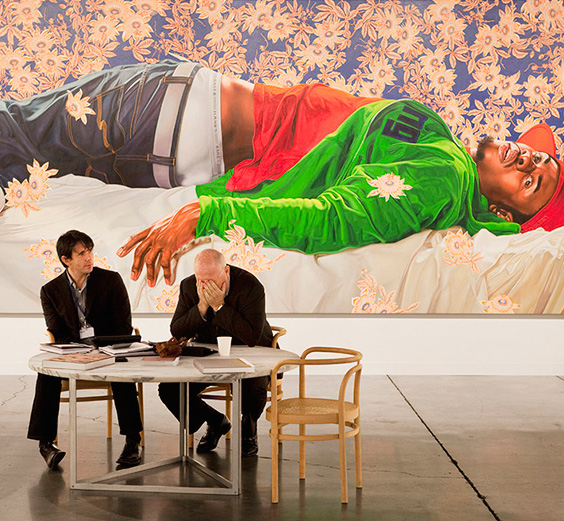If you’re going to Scarborough Fair . . .
 At Quartz, someone actually wrote this:
At Quartz, someone actually wrote this:
“Anyone who is a serious member of the creative class,” Art Basel director Marc Spiegler told Reuters last week, “is going to come into our fair. We’re getting a lot of requests from CEOs and CMOs who’ve never come to the fair.” In other words, there is a legitimate turn taking place as the idea of an immensely lucrative contemporary art market ceases to seem like a sign some market bubble is about to pop. With each passing year, contemporary art becomes a more plausible tent-pole for the global creative economy.
I love how two sentences can herd the creative class into very close quarters with CEOs. The opportunity and income gap is nowhere more extreme than in art. As soon as someone says a hyper-inflated market for things of extremely flexible value isn’t a bubble, you know it’s a bubble. A long-lasting one, maybe, but nevertheless. The point of the article is that art may be going the way of high-end cuisine, becoming accessible to a far larger market, though it seems it might be compared more accurately to tulip bulbs than to the latest iteration of risotto with chile oil.
“Anyone who is a serious member of the creative class is going to come to our fair.” I could make a long list of names of hugely talented members of the creative class who don’t have the time for it because they are too busy being creative.
The Economist explains that the big fair has spawned a lot of satellite events and galleries, as well as parties, and whatever money settles into that river delta of spending will go to emerging artists. Fair enough, no pun intended. But mostly its a carnival of conspicuous consumption, isn’t it?
Throughout all this, Miamians put up with the influx of cognoscenti and socialites with good humour. It does not matter that the traffic is snarled up and pretentious outsiders are flaunting their bulging bank accounts; this is a colourful pageant that not only bolsters the local economy but showcases genuine, creative talent. And with winter setting in elsewhere, the warm sunshine is fantastic. The city has come a long way from being the place where, as Lenny Bruce put it in the 1970s, ”neon goes to die”.
For a week or two, then, the exceptional artist who has merely average income might have a chance to happen upon people who love his or her work enough to pay for it. But it’s hard to see how this helps most galleries in New York City or in smaller cities around the country actually stay in the black from month to month. And it’s hard to imagine decent little galleries in mid-sized cities being able to afford a presence at Art Basel.
The Quartz article suggests to me that primarily Art Basel still offers the super-rich an opportunity to sell to the super-rich with a growing attendance from actually creative people who show up out of voyeuristic curiosity. The premise is that the world is becoming more and more visually sophisticated, thanks to Instagram, Facebook, and a life increasingly devoted to looking at electronic screens for communication, information and entertainment. What the article doesn’t explore is how the economics of all this would actually change in favor of the middle class: how the affordable mid-value work, what used to be the emerging effort that had the most potential to go up in value, if a beginning collector placed his or her bets properly, now gets overlooked in favor of the obscenely priced work which appears to be guaranteed to increase in value. The illusion of this insulated jet-set economy is that the creative risk of the buyer has been removed: it’s an investment with a lock on profit. That does impose on visual art a tent-pole mentality from the movie industry, though it’s hard to see how sales at Art Basel will help fund the work of artists who make little for their efforts, the way a major movie could give a studio enough profit to make lesser, award-worthy fare. I guess the answer would be: come to Miami and put up your little booth and try to tell your work once a year to the buyers who can’t afford Koons. The tent-pole model has already been adopted by the book business, with its focus on blockbuster tomes at the expense of the mid-list. I’m not sure how the entire “creative class” will benefit from the fact that unimaginable sums of money move from one enormous bank account to another as a result of a big art fair. Good movies can still make money. Good books too. Good paintings as well. There is some fine work at Art Basel. But as always, art fair or no art fair, it’s a tiny percentile of the creative class who can actually do it for a living, and to have to start modeling one’s idea of how to reach people with a painting on what happens at Art Basel is a very depressing prospect.
Comments are currently closed.